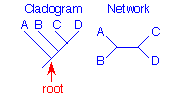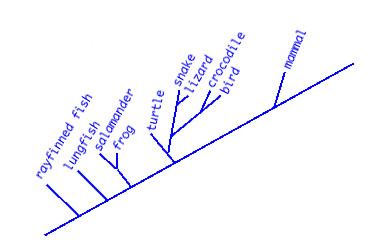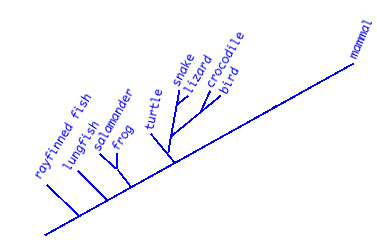 Return to Biology 461 Home Page
Return to Biology 461 Home Page
Back
or  Return to Biology 461 Home Page
Return to Biology 461 Home Page
Copyright © 2000 - 2005 D.J. Eernisse. All Rights Reserved.


Cladograms and networks can be portrayed in a sometimes bewildering diversity of styles. You are not alone if you find their interpretation confusing. The following overview will help focus attention on the important aspects of cladograms that remain the same, regardless of their differing styles.

Notice that Figure B is slightly taller than Figure A. This difference means nothing, because the vertical axis means nothing. That is, it doesn't matter how long the branches are drawn. The only thing that matters is which taxa join at nodes. Likewise, the horizontal axis means nothing. You can draw cladograms as fat or as skinny as you like and it will not change the cladogram, provided the sister taxon relationships are the same.
 This is almost the same cladogram too, but it has some problems. First, notice that the bottom diagonal line extends
from the root to the upper-right-hand corner. This illustrates the phantom taxon problem, which is actually very
commonly seen in students' cladograms drawn for exams (but wrong). Notice there is a node joining mammal to a continuation of
the bottom diagonal line that ends at the far right, as an unlabeled terminal node. This extra taxon makes the
cladogram nonequivalent to A-D above. It
would be counted as incorrect, for example, on an exam. To correct it, always make sure the lower diagonal line
ends at the last terminal node, as in the cladogram below.
This is almost the same cladogram too, but it has some problems. First, notice that the bottom diagonal line extends
from the root to the upper-right-hand corner. This illustrates the phantom taxon problem, which is actually very
commonly seen in students' cladograms drawn for exams (but wrong). Notice there is a node joining mammal to a continuation of
the bottom diagonal line that ends at the far right, as an unlabeled terminal node. This extra taxon makes the
cladogram nonequivalent to A-D above. It
would be counted as incorrect, for example, on an exam. To correct it, always make sure the lower diagonal line
ends at the last terminal node, as in the cladogram below.
 This modified cladogram is now equivalent to A-D above but, while it is technically equivalent, it could be improved.
The second problem with both this and the last cladogram is that they reveal subtle problems with the way their
artist could be viewing evolution. Notice that there is a ladder-like arrangement of taxa, from the "primitive" fish
to the "advanced" mammal, implying that the right-hand taxa are progressively more advanced than those to the
left. This is not how evolution works! The lungfish may be primitive in many respects, but in others it is highly
advanced. Lungfish living today did not stop evolving after they last shared a common ancestor with the mammal.
In this class, try to avoid referring to taxa as primitive or advanced. These are terms that are best
reserved for particular traits that members of an organism have. This point is implied when one puts all of the terminal
taxa at the same level, generally either across the top (Figs. A, B, and D) or in a single column (Fig. C).
So the point here is that bushy cladogram style is generally preferred to ladder-like cladogram style.
This modified cladogram is now equivalent to A-D above but, while it is technically equivalent, it could be improved.
The second problem with both this and the last cladogram is that they reveal subtle problems with the way their
artist could be viewing evolution. Notice that there is a ladder-like arrangement of taxa, from the "primitive" fish
to the "advanced" mammal, implying that the right-hand taxa are progressively more advanced than those to the
left. This is not how evolution works! The lungfish may be primitive in many respects, but in others it is highly
advanced. Lungfish living today did not stop evolving after they last shared a common ancestor with the mammal.
In this class, try to avoid referring to taxa as primitive or advanced. These are terms that are best
reserved for particular traits that members of an organism have. This point is implied when one puts all of the terminal
taxa at the same level, generally either across the top (Figs. A, B, and D) or in a single column (Fig. C).
So the point here is that bushy cladogram style is generally preferred to ladder-like cladogram style.
Return to Biology 461 Home Page
 CSU Fullerton, Biological Science
Home Page
CSU Fullerton, Biological Science
Home Page